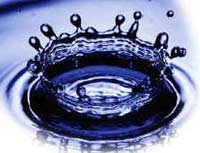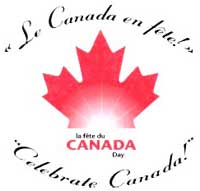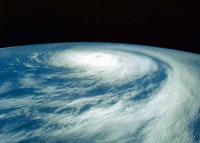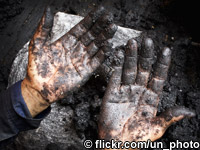
News |
- Ontario Peat for Power Generation
- Carbon Capture Storage - Dubious Results
- U.S. Climate Report Identifies Major Impacts
- Manitoba Climate Change Bill Goes to Review
- Manitoba GHGs Rise Again
- Water Celebrated in 2008!
- Celebrate Canada
- Grassy Narrows Victory - Company Pulls Out
- Canadian Mining Laws Need Overhaul
- Climate Change Animated Maps
- Cellulosic Ethanol - Energy from Waste
- Environmental Defense Promotes Green Innovations
| Ontario Peat for Power Generation | 16 June 08 |
 Ontario Power Generation may be approved to test burn peat at its Atikokan Generating Station. OPG is interested in replacing 20 percent of its current generation of electricity from coal burning with peat. Harvesting Northern Ontario peatlands may also fuel building conflict between First Nations and government over resource extraction projects. Ontario Power Generation may be approved to test burn peat at its Atikokan Generating Station. OPG is interested in replacing 20 percent of its current generation of electricity from coal burning with peat. Harvesting Northern Ontario peatlands may also fuel building conflict between First Nations and government over resource extraction projects.The proposal's public review period came to a close during a recent week long Aboriginal protest at the Ontario Legislature by members and supporters of Kitchenuhmaykoosib Inninuwug (KI), Ardoch Algonquins, Grassy Narrows about their right to oppose mineral exploration and logging on their lands. Environmental advocate Wildlands League opposes the proposal to burn peat arguing that extraction will destroy a significant carbon reservoir, increase greenhouse gas emissions and cause harm to northern ecosystems. According to the International Panel on Climate Change (IPCC), peat is less efficient and produces more carbon dioxide emissions than coal and natural gas. Peat is not considered a biofuel by the IPCC because the rate of renewal at 20-60 cm per 1000 years is too slow. View Wildlands League Proposal to Test Burn Peat on EBR View Ontario Environmental Registry - Ontario Power Generation View May 27, 2008 Canadian Press article (PDF) View May 26, 2008 Wildlands League press release (PDF) Visit Peat Resources Limited - The Cleaner Alternative Sources: Wildlands League, Government of Ontario, Peat Resources |
|
 Print version Print version |
Top |
| Carbon Capture Storage - Dubious Results | 16 June 08 |
 Governments world-wide are looking towards carbon capture and storage (CCS) as reason to build hundreds of coal power plants - the largest single source of carbon dioxide emissions, in the next decade. Governments world-wide are looking towards carbon capture and storage (CCS) as reason to build hundreds of coal power plants - the largest single source of carbon dioxide emissions, in the next decade. According to a recent report from Greenpeace International, CCS is a largely unproven method of injecting CO2 produced by power plants deep underground and is not expected to be technically feasible before 2030. The International Energy Agency (EIA) estimates that by 2050, at least 6000 storage projects need to be in operation. Presently, only three such storage projects exist worldwide. The Greenpeace report False Hope - Why carbon capture and storage won't work to save the climate identifies significant risks to storing CO2 underground and possible leakage rates as low as 1 percent canceling out any climate benefit. Environmentalists fear the lure of CCS will divert investment away from the real solutions to dangerous global climate change - renewable energies and energy efficiency technologies. "Carbon capture and storage is a scam. It is the ultimate coal industry pipe dream," said the report's author, Emily Rochon, climate and energy campaigner at Greenpeace International. The report promotes investment in clean energies - wind, wave, and solar powers which are capable of providing six times more energy than the world currently consumes. View Greenpeace report, False Hope - Why carbon capture and storage won't work to save the climate (PDF) View Greenpeace Statement on Carbon Capture and Storage (PDF) View May 23, 2008 Planet Ark article View June 3, 2008 E-Wire article View May 30, 2008 New York Times article View May 5, 2008 Greenpeace press release Sources: GreenPeace, Planet Ark, E-wire, New York Times |
|
 Print version Print version |
Top |
| U.S. Climate Report Identifies Major Impacts | 16 June 08 |
 Drought, increased erosion, loss of species, damaged rangelands, and insect infestations are among the devastating consequences of climate change projected in a new USDA report. Drought, increased erosion, loss of species, damaged rangelands, and insect infestations are among the devastating consequences of climate change projected in a new USDA report. The United States Department of Agriculture's final report, The Effects of Climate Change on Agriculture, Land Resources, Water Resources and Biodiversity reflects a shift in the US administration's previous work on climate science. The report identifies current and anticipated impacts to resource based sectors and sets priorities for research, observation and decision support needs. Examples of more than 80 climate change impacts produce an uneven national map of harms and benefits. The report is part of a broader federal 'Strategic Plan for Climate Change', focusing on the next 25 to 50 years that will integrate climate change adaption into national forest, natural resource conservation, and farm services. USDA is taking a proactive approach, offering new tools to manage drought risks, estimate carbon footprints and reduce greenhouse gas emissions. View US Agriculture report, The Effects of Climate Change on Agriculture, Land Resources, Water Resources, and Biodiversity in the United States, 2008 (PDF) View May 27, 2008 Salt Lake Tribune article View May 28, 2008 New York Times article View May 28, 2008 Casper Star Tribune article View May 27, 2008 USDA article Sources: US Climate Change Science Program, USDA, Salt Lake Tribune, New York Times, Star Tribune |
|
 Print version Print version |
Top |
| Manitoba Climate Change Bill Goes to Review | 11 June 08 |
 Bill 15, The Climate Change and Emissions Reductions Act, was tabled in the Manitoba Legislature in May 2008. At the press conference that day Premier Doer declared that Manitoba's reductions targets for green houses gases would be achieved by actual reductions inside Manitoba. Bill 15 will become an Act through stages that include: review by an all-party legislative review committee, writing and enacting various regulations under the Act, etc. Bill 15, The Climate Change and Emissions Reductions Act, was tabled in the Manitoba Legislature in May 2008. At the press conference that day Premier Doer declared that Manitoba's reductions targets for green houses gases would be achieved by actual reductions inside Manitoba. Bill 15 will become an Act through stages that include: review by an all-party legislative review committee, writing and enacting various regulations under the Act, etc.More recently Bill 15 was open to public comments at a session of the all party Legislative Review Committee of the Manitoba legislature. Gaile Whelan Enns, director of Manitoba Wildlands, appeared before the committee to support the Bill, and recommend steps to strengthen the Bill. View Manitoba Government Bill 15 The Climate Change and Emissions Reductions Act View May 26, 2008 Manitoba Standing Committee On Social And Economic Development Hearing (PDF) Page #12 View May 26, 2008 Gaile Whelan Enns Comments at the Manitoba Standing Committee Hearing (DOC) View April 11, 2008 Manitoba Government press release Sources: Government of Manitoba, Manitoba Wildlands |
|
 Print version Print version |
Top |
| Manitoba GHGs Rise Again | 10 June 08 |
 Between 2005 and 2006, Manitoba's greenhouse gas emissions rose by more than 150,000 tonnes (0.15 megatonnes (mt)) to 21.77 mt - one of the highest amounts for the province on the books. Between 2005 and 2006, Manitoba's greenhouse gas emissions rose by more than 150,000 tonnes (0.15 megatonnes (mt)) to 21.77 mt - one of the highest amounts for the province on the books.The 2006 emissions were nearly 13% above 1990 levels, while the Kyoto Protocol target - which the Manitoba government has been committed to since 2002) - is to bring emissions to 6% below 1990 levels by 2012. Energy Minister Jim Rondeau says green measures introduced by the government over the past couple of years should still allow Manitoba to achieve its Kyoto goal. Manitoba GHG details are not yet available on the Environment Canada website. The executive summary of GHG trends in Canada currently posted contains only aggregate data. As a result, up to date, detailed sectoral information about Manitoba GHG emissions trends over time is not readily available - either from Environment Canada or the Manitoba Government. Manitoba Wildlands Director Gaile Whelan Enns says lack of information would not be an issue if Manitoba had a system in place for reporting greenhouse gas emissions. "We really don't have much information and we don't have a reporting system in Manitoba," she said. "We're dealing with a national system that isn't good enough." View June 5, 2008 Winnipeg Sun articles: one and two View May 16, 2008 Environment Canada Summary of Trends, Canada's 2006 Greenhouse Gas Inventory (pdf) Visit Environment Canada's Greenhouse Gas website View June 5, 2008 Manitoba government press release Sources: Winnipeg Sun, Environment Canada |
|
 Print version Print version |
Top |
| Water Celebrated in 2008! | 10 June 08 |
 Oceans Day June 8th, recognizes the key role oceans play in the Earth's health by encouraging individuals to learn and discover information about aquatic creatures, habitats, and how we can contribute to the protection and conservation of our oceans. Oceans Day June 8th, recognizes the key role oceans play in the Earth's health by encouraging individuals to learn and discover information about aquatic creatures, habitats, and how we can contribute to the protection and conservation of our oceans. Canadian Rivers Day, the second Sunday in June, this year June 8th celebrates Canada's rivers for their rich history and natural heritage. The Canadian Heritage River System (CHRS), celebrates this day by encouraging individuals to go canoeing, create river artwork, or take a nature walk along a river. Rivers to Oceans Week runs from June 8-14, 2008. The Canadian Wildlife Federation is celebrating this weeklong event by raising awareness about water ecosystems and their wildlife. This year's theme is "Beneath the Water's Surface" and will explore how these ecosystems contribute to our daily lives and what we can do to protect them. Visit World Oceans Day Visit Canadian Rivers Day 2008 Visit Rivers to Oceans Week Sources: DFO Canada, CHRS, RiversToOceansWeek.ca |
|
 Print version Print version |
Top |
| Celebrate Canada | 10 June 08 |
 Celebrate Canada is an 11 day event beginning June 21st with National Aboriginal Day followed by Saint Jean-Baptiste Day on June 24th, Multiculturalism Day on June 27th and concluding with Canada on July 1st! Celebrate Canada is an 11 day event beginning June 21st with National Aboriginal Day followed by Saint Jean-Baptiste Day on June 24th, Multiculturalism Day on June 27th and concluding with Canada on July 1st!National Aboriginal Day will be celebrating with events from coast to coast. In Manitoba events are scheduled for a number of venues including the Scotia Main stage at the Forks in Winnipeg. Quebec City is celebrating the day as part of their 400th anniversary theme "The Encounter" between Aboriginals and Europeans. Visit June 21 - Share in the Celebration Sources: Government of Canada |
|
 Print version Print version |
Top |
| Grassy Narrows Victory - Company Pulls Out | 10 June 08 |
 One of the largest logging companies in North America has surrendered its license to log in the Whiskey Jack forest of northwestern Ontario. One of the largest logging companies in North America has surrendered its license to log in the Whiskey Jack forest of northwestern Ontario. The one-million-hectare boreal forest region is considered sacred by Grassy Narrows First Nation and is within their traditional territory. Grassy Narrows First Nation has held the longest running blockade in Canadian history. A recent campaign to end logging in the entire Whiskey Jack forest has gathered support from consumers, environmental, and human rights groups. Abitibi Bowater is willing to surrender its license to cut 700,000 cubic meters of wood each year from the Whiskey Jack forest until 2023 to avoid years of negotiations with Grassy Narrows First Nation. "All companies operating in the boreal forest should take this as a wake-up call," said David Sone of the Rainforest Action Network. "This is proof that communities can say 'no' and enforce their right to control development in their traditional territory." View June 3, 2008 National Post article View June 5, 2008 The Star article View June 4, 2008 Seattle Post Intelligencer article View June 4, 2008 Canada.com article View June 4, 2008 Thunder Bay Chronicle Journal Sources: National Post, The Star, Seattle Post Intelligencer, Canada.com, Thunder Bay Chronicle Journal |
|
 Print version Print version |
Top |
| Canadian Mining Laws Need Overhaul | 03 June 08 |
 Escalating conflicts with First Nation communities over mining claims is attributed to outdated mining laws; a new report released identifies essential changes required to modernize the 150-year-old system. Escalating conflicts with First Nation communities over mining claims is attributed to outdated mining laws; a new report released identifies essential changes required to modernize the 150-year-old system. The International Boreal Conservation Campaign (IBCC) and the Canadian Boreal Initiative released Mining Exploration Conflicts in Canada's Boreal Forest. It contains a set of maps outlining the impact of mining claims which conflict with Aboriginal land claims, private lands, proposed protected areas, and threaten woodland caribou habitat. "Social and environmental objectives - such as resolving Aboriginal land claims and ensuring conservation planning before development - should take precedence. But under the current system, mineral rights are given first priority," said Larry Innes of the Canadian Boreal Initiative. Over a half-million square kilometers or ten percent of Canada's boreal forest regions has been staked for mining. The maps show claims in mines in Canada's Boreal Forest; Claims and Aboriginal and Treaty Rights in Canada's Boreal Forest; and Mineral Exploration and Actives Mines in Caribou Ranges in Canada's Boreal Forest. The maps released were:
View May 27, 2008 Canada.com article View May 14, 2008 CBI press release View May 14, 2008 IBCC Mining Report: Mining Exploration Conflicts in Canada's Boreal Forest View May 18, 2008 Canadian Mining Journal article View May 14, 2008 Canada.com article Sources: IBCC, CBI, Canada.com, Canadian Mining Journal |
|
 Print version Print version |
Top |
| Climate Change Animated Maps | 03 June 08 |
 Google Earth images from NASA satellites are being used to illustrate potential impacts of climate change. Google's interactive and animated maps are a time-lapse series of global warming scenarios over the new century. Google Earth images from NASA satellites are being used to illustrate potential impacts of climate change. Google's interactive and animated maps are a time-lapse series of global warming scenarios over the new century.Google launched the "Climate Change in Our World" project in cooperation with Britain's environmental ministry to produce maps intended to raise awareness about effects of climate change. Animations of temperature changes were created under medium scenario greenhouse gas emissions projections. Maps show changes at a planetary perspective with the ability to zoom in on countries and cities. Users can view loss of Antarctic ice shelves since the 1950s and increased polar temperatures; access information about changing weather patterns, and learn about actions already taken in local areas. Scientists indicate global average temperatures will rise between 1.8 and 4.0 degrees Celsius this century due to carbon emissions from burning fossil fuels for power and transport. View Google Earth Outreach KML: Climate in Our World View May 19, 2008 UK Met Office press release View May 21, 2008 PlanetArk article View May 19, 2008 The Environmental Leader article View May 20, 2008 Sustainable Business article Visit Project Vulcan website Sources: Google Earth, Met Office, Planet Ark, The Environmental Leader, Sustainable Business, Project Vulcan |
|
 Print version Print version |
Top |
| Cellulosic Ethanol - Energy from Waste | 03 June 08 |
 Cellulosic ethanol, a renewable biofuel product made from municipal, agricultural or forest waste is said to reduce GHGs by up to 87 percent, according to the US Department of Energy's GREET model. Cellulosic ethanol, a renewable biofuel product made from municipal, agricultural or forest waste is said to reduce GHGs by up to 87 percent, according to the US Department of Energy's GREET model.Not yet widely available, cellulose ethanol does not exploit food crops and agricultural land like corn ethanol but uses biomass leftovers - corn stalks, sugar cane, wheat stalks, sawdust, tree branches, and organic waste. "With food and gas prices surging at double-digit rates, there is an imperative for sustainable biofuels technologies." said Charles Holliday, DuPont chairman and chief. With an estimated global market opportunity of $75 billion, companies in Canada and the Untied States are quickly opening new cellulosic ethanol facilities. Chemical giants DuPont and Genencor, a Danisco division, are entering into a partnership and will open its first cellulosic factory in the United States in 2009. GreenField Ethanol hired Frank Dottori as managing director of its cellulosic ethanol division. Dottori founded Tembec Inc. in 1972 and retired in 2006. At the age of 69 he will help "make cellulosic ethanol a commercial reality". View May 14, 2008 World Business Council for Sustainable Development release View May 2, 2008 Canada.com article View March 6, 2008 Canada.com article View May 28, 2008 NewsWire article Visit Lignol Energy Cellulosic Ethanol website Visit Enerkem Inc. website Visit GreenField Ethanol website Sources: World Business Council for Sustainable Development, Canada.com, Canoe.ca, Newswire |
|
 Print version Print version |
Top |
| Environmental Defense Promotes Green Innovations | 03 June 08 |
 Environmental Defense Fund U.S. highlights leading green business trends and practices in its first edition of Innovations Review 2008: Making Green the New Business as Usual. Environmental Defense Fund U.S. highlights leading green business trends and practices in its first edition of Innovations Review 2008: Making Green the New Business as Usual.With and advisory panel of experts, the Fund reviewed processes, products and technologies out of more than 230 ideas based on four criteria: environmental benefits, business benefits, replicability, and creativity. The ideas in Innovations Review 2008 show how building environmental considerations into basic business processes can create competitive advantage. We hope these ideas inspire others to reduce waste or improve energy efficiency in their operations, services and supply chains and strengthen the bottom line in the process. said Environmental Defense Fund Executive Director David Yarnold. View Environmental Defense Fund Innovations Review 2008: Making Green the New Business as Usual (PDF) View May 21, 2008 GreenBiz article View May 20, 2008 Environmental Defense Fund press release View May 20, 2008 Media Wire article Sources: GreenBiz, Environmental Defense Fund, Media Wire |
|
 Print version Print version |
Top |


 RSS Feeds:
RSS Feeds: